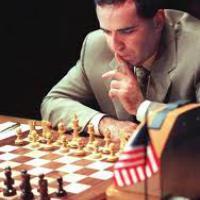
French Defence - Adavnce Variation.
The French Defence is a chess opening. It is characterised by the moves:
The French has a reputation for solidity and resilience, though it can result in a somewhat cramped game for Black in the early stages. Black often gains counterattacking possibilities on the queenside while White tends to concentrate on the kingside.
Following the opening moves 1.e4 e6, the game usually continues 2.d4 d5 (see below for alternatives). White expands his claim on the centre, while Black immediately challenges the pawn on e4.
White has several main options—he can defend it with 3.Nc3 or 3.Nd2, he can exchange with 3.exd5, or he can advance the pawn with 3.e5, which leads to different types of positions. Note that 3.Bd3? is bad as it allows 3...dxe4 4.Bxe4 Nf6.
History
The French Defence is named after a match played by correspondence between the cities of London and Paris in 1834 (although earlier examples of games with the opening do exist). It was Chamouillet, one of the players of the Paris team, who convinced the others to adopt this defense.[7]
As a reply to 1.e4, the French Defence received relatively little attention in the nineteenth century compared to 1...e5. The first world chess champion Wilhelm Steinitz said "I have never in my life played the French Defense, which is the dullest of all openings".[8] In the early 20th century, Géza Maróczy was perhaps the first world-class player to make it his primary weapon against 1.e4. For a long time, it was the third most popular reply to 1.e4, behind only 1...c5 and 1...e5. However, according to the Mega Database 2007, in 2006, 1...e6 was second only to the Sicilian in popularity.
Historically important contributors to the theory of the defence include Mikhail Botvinnik, Viktor Korchnoi, Aron Nimzowitsch, Tigran Petrosian, Lev Psakhis, Wolfgang Uhlmann and Rafael Vaganian. More recently, its leading practitioners include Evgeny Bareev, Alexey Dreev, Mikhail Gurevich, Alexander Khalifman, Smbat Lputian, Alexander Morozevich, Teimour Radjabov, Nigel Short, Gata Kamsky, and Yury Shulman.
The Exchange Variation was recommended by Howard Staunton in the 19th century,[9] but has been in decline ever since. In the early 1990s Garry Kasparov briefly experimented with it before switching to 3.Nc3. Note that Black's game is made much easier as his queen's bishop has been liberated. It has the reputation of giving immediate equality to Black, due to the symmetrical pawn structure.
Like the Exchange, the Advance Variation was frequently played in the early days of the French Defence. Aron Nimzowitsch believed it to be White's best choice and enriched its theory with many interesting ideas. However, the Advance declined in popularity throughout most of the 20th century until it was revived in the 1980s by GM and prominent opening theoretician Evgeny Sveshnikov, who continues to be a leading expert in this line. In recent years, it has become nearly as popular as 3.Nd2; GM Alexander Grischuk has championed it successfully at the highest levels.
Advance Variation: 3 e5
The main line of the Advance Variation continues 3...c5 4 c3 Nc6 5 Nf3 and then we have a branching point:
5...Qb6, the idea is to increase the pressure on d4 and eventually undermine the White centre. The Queen also attacks the b2 square, so White's dark-squared bishop cannot easily defend the d4 pawn without losing the b2 pawn. White's most common replies are 6 a3 and 6 Be2. 6 a3 is currently the most important line in the Advance: it prepares 7 b4, gaining space on the queenside. Black may prevent this with 6...c4 intending to take en passant if White plays b4, which creates a closed game where Black fights for control of the b3 square. On the other hand, Black may continue developing with 6...Nh6, intending ...Nf5 this might seem strange as White can double the pawn with Bxh6, but this is actually considered good for Black. Black plays ...Bg7 and ...O-O and Black's king has adequate defense and White will miss his apparently 'bad' dark squared bishop. 6 Be2 is the other alternative, aiming simply to castle. Once again, a common Black response is 6...Nh6 intending 7...cxd4 8 cxd4 Nf5 attacking d4. When the king's knight reaches f5 from h6, there will be three pieces and a pawn attacking the d4 point while there will only be the Nf3, pawn c3, and Qd1 defending the d4 pawn. As said earlier, White's dark-squared bishop cannot come to the rescue because the b2 pawn will fall. Thus, White must plan prophylactically and reply to 6...Nh6 with 7 Na3 preparing to defend the d4 pawn with Nc2.
5...Bd7 was mentioned by Greco as early as 1620, and was revived and popularised by Viktor Korchnoi in the 1970s. Now a main line, the idea behind the move is that since Black usually plays ...Bd7 sooner or later, he plays it right away and waits for White to show his hand. If white plays 6 a3 in response, modern theory says that Black equalises or is better after 6...f6! The lines are complex, but the main point is that a3 is a wasted move if the Black Queen is not on b6 and so Black uses the extra tempo to attack the white centre immediately. Black may continue 7...Nf5 to attack d4 or 7...Ng6 followed by ...f6 to attack e5.
There are alternative strategies to 3...c5 that were tried in the early 20th century such as 3...b6, intending to fianchetto the bad bishop and which can transpose to Owen's Defence or 3...Nc6, played by Carlos Guimard, intending to keep the bad bishop on c8 or d7 which is passive and obtains little counterplay. Also, 4...Qb6 5 Nf3 Bd7 intending 6...Bb5 to trade off the "bad" queen's bishop is possible.